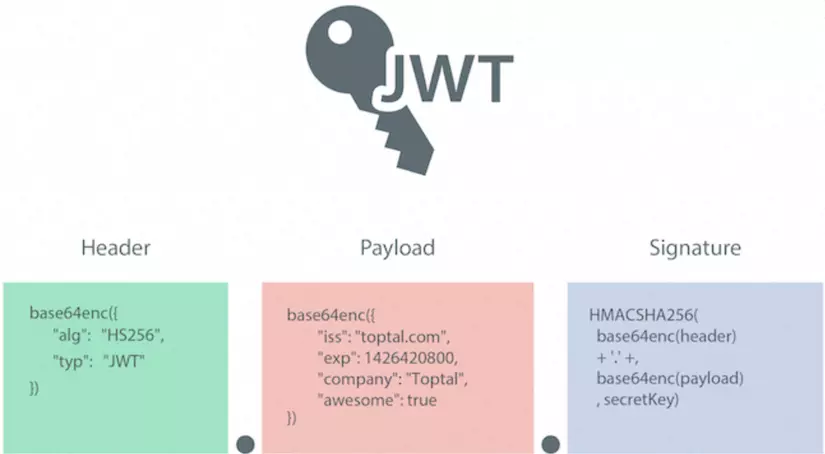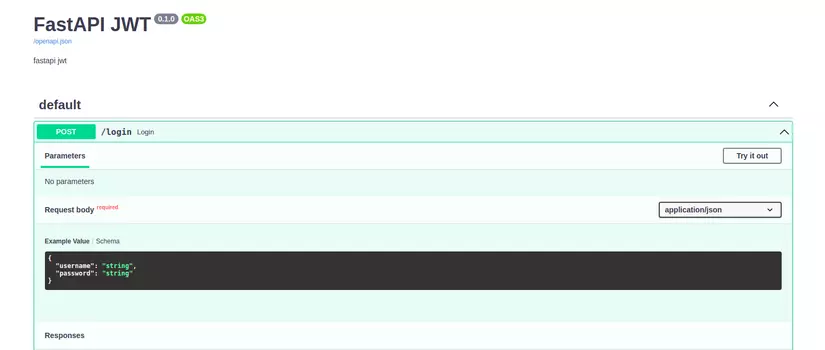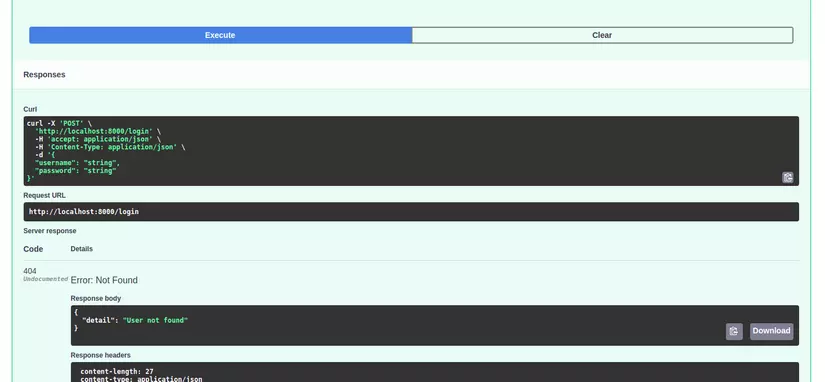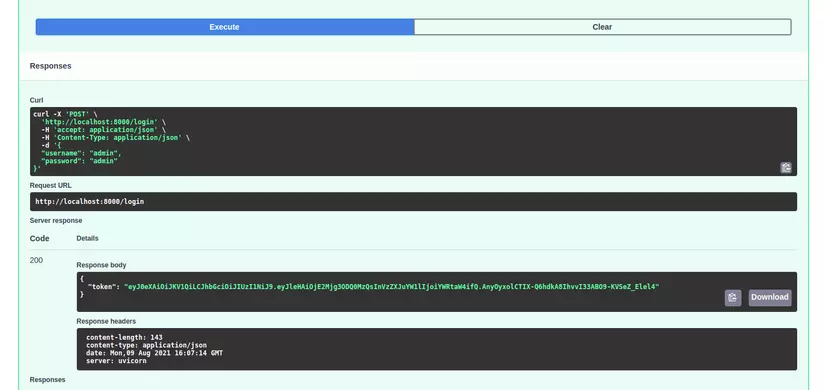FastAPI JWT
Login with json-web-token in Fastapi

Intro: Quick guide to setup login with JWT in Fastapi
Thinking: với cơ chế serverless thông thường các bước xác thực User trong một service backend qua API thường diễn ra như sau:
- User cung cấp username + password và call API login để lấy mã xác thực (JWT token)
- User sử dụng mã xác thực JWT do hệ thống cung cấp, thêm mã này vào trong header của mỗi request để hệ thống check mỗi khi call API
Như chúng ta đã biết hoặc ở trang chủ của FastAPI đã viết
FastAPI is a modern, fast (high-performance), web framework for building APIs with Python 3.6+ based on standard Python type hints.
Ở đây mình sẽ viết một quick setup để cài đặt sử dụng JWT trong FastAPI. Chủ yếu chúng ta có 2 bước:
- Viết API Login để get JWT token
- Viết 1 API get data bất kỳ, required JWT token thì mới get được data
Step1: Setup a FastAPI service
Đầu tiên, install fastapi và tạo file main.py và thêm vài dòng code để chắc chắn FastAPI chạy được
# Terminal CLI
$ pip install fastapi uvicorn
# File main.py
import uvicorn
from fastapi import FastAPI
app = FastAPI(
title='FastAPI JWT', openapi_url='/openapi.json', docs_url='/docs',
description='fastapi jwt'
)
@app.post('/login')
def login():
return 'Success'
@app.get('/books')
def list_books():
return {'data': ['Sherlock Homes', 'Harry Potter', 'Rich Dad Poor Dad']}
if __name__ == '__main__':
uvicorn.run(app, host='0.0.0.0', port=8000)
Tại giao diện CLI, run command
$ uvicorn main:app --reload
Mở web browser để check http://localhost:8000/docs

Call thử API xem có ra kết quả không nhé
Step2: Tạo form login
Sử dụng Pydantic để tạo form login, giờ form login chỉ cần 2 field là username và password.
- Thêm class LoginRequest
- Thêm request_data vào function login & dùng print để show request_data trên CLI
# File main.py
...
from pydantic import BaseModel
app = FastAPI(
title='FastAPI JWT', openapi_url='/openapi.json', docs_url='/docs',
description='fastapi jwt'
)
class LoginRequest(BaseModel):
username: str
password: str
@app.post('/login')
def login(request_data: LoginRequest):
print(f'[x] request_data: {request_data.__dict__}')
return 'Success'
...
Check webrower, trong request body đã show form rồi

Click Try it out, nhập thử username & password: test/test và check CLI

Step3: function verify_password
Nhập username, password tất nhiên sẽ cần 1 function để check xem username/password có đúng không, viết 1 function đơn giản check username và password có bằng admin/admin không
# File main.py
import uvicorn
from fastapi import FastAPI, HTTPException
from pydantic import BaseModel
...
def verify_password(username, password):
if username == 'admin' and password == 'admin':
return True
return False
@app.post('/login')
def login(request_data: LoginRequest):
print(f'[x] request_data: {request_data.__dict__}')
if verify_password(username=request_data.username, password=request_data.password):
return 'Success'
else:
raise HTTPException(status_code=404, detail="User not found")
...
Logic là nếu username/password = admin/admin thì return Success, nếu không thì return 404 – User not found
Test thử trường hợp not found

Step4: Generate & return token
Khi nhập đúng username/password, api login cần trả ra JWT token, vậy nên giờ ta viết hàm gentoken
- Cài đặt PyJWT, để generate jwt token, ta cần sử dụng thư viện PyJWT. Open CLI and run:
$ pip install PyJWT
- Tạo function generate_token, return value của function này thay cho return ‘Success’
# File main.py
import jwt
import uvicorn
from datetime import datetime, timedelta
from typing import Union, Any
from fastapi import FastAPI, HTTPException
from pydantic import BaseModel
SECURITY_ALGORITHM = 'HS256'
SECRET_KEY = '123456'
...
def generate_token(username: Union[str, Any]) -> str:
expire = datetime.utcnow() + timedelta(
seconds=60 * 60 * 24 * 3 # Expired after 3 days
)
to_encode = {
"exp": expire, "username": username
}
encoded_jwt = jwt.encode(to_encode, SECRET_KEY, algorithm=SECURITY_ALGORITHM)
return encoded_jwt
@app.post('/login')
def login(request_data: LoginRequest):
print(f'[x] request_data: {request_data.__dict__}')
if verify_password(username=request_data.username, password=request_data.password):
token = generate_token(request_data.username)
return {
'token': token
}
else:
raise HTTPException(status_code=404, detail="User not found")
...
Thử call API và xem kết quả

Kết quả là chuỗi token bao gồm 3 phần
Step5: Required header Token khi call API books
Để thêm form nhập token ở Swagger và check required token, FastAPi đã tích hợp sẵn lib tiện ích
là HTTPBearer.
- Trong security.py, thêm reusable_oauth2 là instance của HTTPBearer
- Sử dụng reusable_oauth2 làm dependencies trong API books
# File security.py
from fastapi.security import HTTPBearer
reusable_oauth2 = HTTPBearer(
scheme_name='Authorization'
)
# File main.py
...
from security import validate_token, reusable_oauth2
...
@app.get('/books', dependencies=[Depends(reusable_oauth2)])
def list_books():
return {'data': ['Sherlock Homes', 'Harry Potter', 'Rich Dad Poor Dad']}
...
Quay lại webrowser, có thể thấy biểu tượng khóa và button Authorize ở góc trên bên phải

Call thử API /books mà không nhập token, sẽ thấy response "detail": "Not authenticated"
Step6: validate_token
Sau khi hiểu sơ qua công dụng của HTTPBearer, ta sử dụng nó để get token và check tính hợp lệ
- Trong security.py thêm function validate_token
- Sử dụng validate_token làm dependencies trong API books
# File security.py
from datetime import datetime
import jwt
from fastapi import Depends, HTTPException
from fastapi.security import HTTPBearer
from pydantic import ValidationError
SECURITY_ALGORITHM = 'HS256'
SECRET_KEY = '123456'
reusable_oauth2 = HTTPBearer(
scheme_name='Authorization'
)
def validate_token(http_authorization_credentials=Depends(reusable_oauth2)) -> str:
"""
Decode JWT token to get username => return username
"""
try:
payload = jwt.decode(http_authorization_credentials.credentials, SECRET_KEY, algorithms=[SECURITY_ALGORITHM])
if payload.get('username') < datetime.now():
raise HTTPException(status_code=403, detail="Token expired")
return payload.get('username')
except(jwt.PyJWTError, ValidationError):
raise HTTPException(
status_code=403,
detail=f"Could not validate credentials",
)
# File main.py
...
from security import validate_token
...
@app.get('/books', dependencies=[Depends(validate_token)])
def list_books():
return {'data': ['Sherlock Homes', 'Harry Potter', 'Rich Dad Poor Dad']}
...
Quay lại webrowser, call APi login để get token và nhập token đó để call API /books xem sao nhé.
Conclusion
Tích hợp JWT vào FastAPI khá là đơn giản, điều quan trọng là chúng ta cần biết sử dụng
HTTPBearer và dependencies là những công cụ có sẵn được cung cấp bởi framework.
Ngoài ra nếu được có thể tìm hiểu thêm về cơ chế hoạt động của lib PyJWT tại https://pyjwt.readthedocs.io/en/stable/
Run this project
Để run project này:
$ git clone https://github.com/Longdh57/fastapi-jwt.git
$ cd fastapi-jwt
$ virtualenv -p python3 .venv
$ source .venv/bin/active
$ pip install -r requirements.txt
$ uvicorn main:app --reload
Nguồn: viblo.asia
